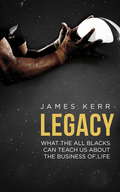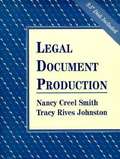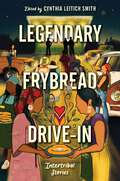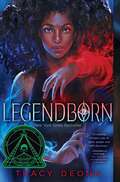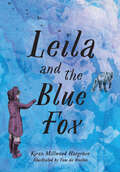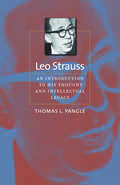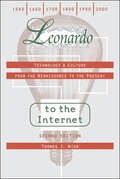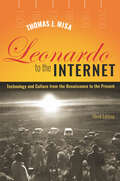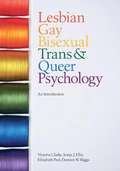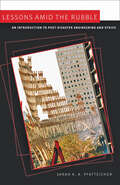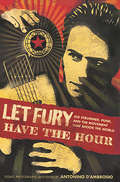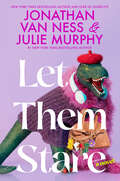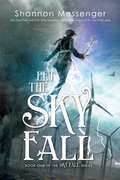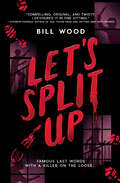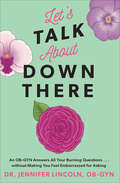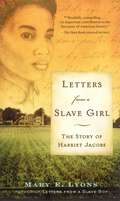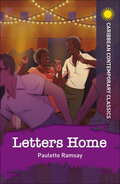- Table View
- List View
Legacy: What The All Blacks Can Teach Us About The Business Of Life (Contemporary Security Studies)
by James KerrChampions do extra. They sweep the sheds. They follow the spearhead. They keep a blue head. They are good ancestors. In Legacy, best-selling author James Kerr goes deep into the heart of the world's most successful sporting team, the legendary All Blacks of New Zealand, to reveal 15 powerful and practical lessons for leadership and business. Legacy is a unique, inspiring handbook for leaders in all fields, and asks: What are the secrets of success - sustained success? How do you achieve world-class standards, day after day, week after week, year after year? How do you handle pressure? How do you train to win at the highest level? What do you leave behind you after you're gone? What will be your legacy?
Legal Document Production
by Nancy Creel Smith Tracy Rives JohnstonThis combination book/workbook/reference provides a well-rounded overview of the procedures to follow in producing legal documents in six areas of law, general legal correspondence, and miscellaneous documents. Readers gain hands-on experience formatting and producing documents using any software package, word processor, electronic typewriter, or standard typewriter. The book provides a realistic approach to the procedural process required in the court system; features a wide variety of hands-on projects that focus on the documents themselves-- i. e. , the projects are suitable for any word processing software used with a computer, electronic typewriter, word processor, or standard typewriter; includes projects that highlight the documents from a variety of states, including specific features of California, Florida, Illinois, New York, Ohio, Texas, Virginia.
Legal Writing (2nd Edition)
by Sheila J. Simon Richard K. Neumann Jr.Written for law students, this well-organized and thorough book shows how to hone legal writing skills in real-world situations. Topics include process, style, memoranda writing, organizing analysis (CREAC), analytical writing, persuasive writing, telling a client's story, making the client's argument, appellate briefs, and oral argument. Each chapter includes exercises. Appendices contain sample memos and briefs. An accompanying access code protected website offers supplementary material including videos, checklists, and articles. Annotation ©2011 Book News, Inc. , Portland, OR (booknews. com)
Legal Writing and Analysis (Third Edition)
by Linda H. EdwardsIdeal for beginning legal writers, this logically organized and exceptionally well-written text offers a concise and straightforward guide to legal writing and analysis. Updated to include exercises with increased focus on first-year courses, Legal Writing and Analysis, Second Edition, starts with an overview of the legal system and the lawyer¿s role, then leads students from reading and analyzing the law through the process of legal writing, providing numerous examples and exercises along the way. Classroom-tested features of this bestselling text include: a consistent use of the legal method approach, from an opening chapter providing an overview of a civil case and the lawyer¿s role, to information about the legal system, case briefing, synthesizing cases, and statutory interpretation an emphasis on analogical reasoning and synthesizing cases, as well as rule-based and policy-based reasoning, with explanations of how to use these types of reasoning to organize a legal discussion a logical organization that starts with reading and analyzing the law and then moves on to writing the discussion of a legal question, writing an office memo and professional letters, and advocacy writing. chapters addressing style and formality considerations as well as oral advocacy effective coverage of the use of precedent a superior discussion of small-scale organization, including the thesis paragraph numerous examples and frequent short exercises that encourage students to apply concepts a comprehensive Teacher¿s Manual that offers helpful advice for instructors. The Second Edition offers new exercises, including increased focus on first-year courses. a revision of Part Five on advocacy writing, streamlining the order of the chapters and adding more coverage of questions presented an updated citation chapter. Chapter 12 on the Office Memorandum has been expanded to add another format for a question presented and is accompanied by an example
Legal Writing in Plain English: A Text with Exercises
by Bryan A. GarnerAdmirably clear, concise, down-to-earth, and powerful-- unfortunately, these adjectives rarely describe legal writing, whether in the form of briefs, opinions, contracts, or statutes. In Legal Writing in Plain English, Bryan A. Garner provides lawyers, judges, paralegals, law students, and legal scholars sound advice and practical tools for improving their written work. The book encourages legal writers to challenge conventions and offers valuable insights into the writing process: how to organize ideas, create and refine prose, and improve editing skills. In essence, it teaches straight thinking-- a skill inseparable from good writing. Replete with common sense and wit, the book draws on real-life writing samples that Garner has gathered through more than a decade of teaching in the field. Trenchant advice covers all types of legal materials, from analytical and persuasive writing to legal drafting. Meanwhile, Garner explores important aspects of document design. Basic, intermediate, and advanced exercises in each section reinforce the book's principles. (An answer key to basic exercises is included in the book; answers to intermediate and advanced exercises are provided in a separate Instructor's Manual, free of charge to instructors.) Appendixes include a comprehensive punctuation guide with advice and examples, and four model documents. Today more than ever before, legal professionals cannot afford to ignore the trend toward clear language shorn of jargon. Clients demand it, and courts reward it. Despite the age-old tradition of poor writing in law, Legal Writing in Plain English shows how legal writers can unshackle themselves. Legal Writing in Plain English includes: *Tips on generating thoughts, organizing them, and creating outlines. *Sound advice on expressing your ideas clearly and powerfully. *Dozens of real-life writing examples to illustrate writing problems and solutions. *Exercises to reinforce principles of good writing (also available on the Internet). *Helpful guidance on page layout. *A punctuation guide that shows the correct uses of every punctuation mark. *Model legal documents that demonstrate the power of plain English.
Legend of the White Snake
by Sher LeeA snake spirit transforms into a boy and must hide his true identity after falling for a headstrong prince in this lush, romantic retelling of the traditional Chinese folktale. When Prince Xian was a boy, a white snake bit his mother and condemned her to a slow, painful death. The only known cure is an elusive spirit pearl—or an antidote created from the rare white snake itself. Desperate and determined, Xian travels to the city of Changle, where an oracle predicted he would find and capture a white snake.Seven years ago, Zhen, a white snake in the West Lake, consumed a coveted spirit pearl, which gave him special powers—including the ability to change into human form.In Changle, Xian encounters an enigmatic but beautiful stable boy named Zhen. The two are immediately drawn to each other, but Zhen soon realizes that he is the white snake Xian is hunting. As their feelings grow deeper, will the truth about Zhen’s identity tear them apart?
Legendary Frybread Drive-In: Intertribal Stories
by Cynthia Leitich Smith Eric Gansworth David A. Robertson Jen Ferguson Darcie Little Badger Marcella Bell Angeline Boulley Andrea L. Rogers Kate Hart Byron Graves K. A. Cobell Cheryl Isaacs Brian Young Karina Iceberg Kaua Mahoe Adams Christine Hartman Derr A. J. EversoleFeaturing the voices of both new and acclaimed Indigenous writers and edited by bestselling Muscogee author Cynthia Leitich Smith, this collection of interconnected stories serves up laughter, love, Native pride, and the world’s best frybread.The road to Sandy June's Legendary Frybread Drive-In slips through every rez and alongside every urban Native hangout. The menu offers a rotating feast, including traditional eats and tasty snacks. But Sandy June's serves up more than food: it hosts live music, movie nights, unexpected family reunions, love long lost, and love found again.That big green-and-gold neon sign beckons to teens of every tribal Nation, often when they need it most.Featuring stories and poems by: Kaua Mahoe Adams, Marcella Bell, Angeline Boulley, K. A. Cobell, A. J. Eversole, Jen Ferguson, Eric Gansworth, Byron Graves, Kate Hart, Christine Hartman Derr, Karina Iceberg, Cheryl Isaacs, Darcie Little Badger, David A. Robertson, Andrea L. Rogers, Cynthia Leitich Smith, and Brian Young.In partnership with We Need Diverse Books.
Legendborn (The Legendborn Cycle #1)
by Tracy DeonnAn Instant New York Times Bestseller! Winner of the Coretta Scott King - John Steptoe for New Talent Author Award Filled with mystery and an intriguingly rich magic system, Tracy Deonn&’s YA contemporary fantasy reinvents the King Arthur legend and &“braids together Southern folk traditions and Black Girl Magic into a searing modern tale of grief, power, and self-discovery&” (Dhonielle Clayton, New York Times bestselling author of The Belles).After her mother dies in an accident, sixteen-year-old Bree Matthews wants nothing to do with her family memories or childhood home. A residential program for bright high schoolers at UNC–Chapel Hill seems like the perfect escape—until Bree witnesses a magical attack her very first night on campus. A flying demon feeding on human energies. A secret society of so called &“Legendborn&” students that hunt the creatures down. And a mysterious teenage mage who calls himself a &“Merlin&” and who attempts—and fails—to wipe Bree&’s memory of everything she saw. The mage&’s failure unlocks Bree&’s own unique magic and a buried memory with a hidden connection: the night her mother died, another Merlin was at the hospital. Now that Bree knows there&’s more to her mother&’s death than what&’s on the police report, she&’ll do whatever it takes to find out the truth, even if that means infiltrating the Legendborn as one of their initiates. She recruits Nick, a self-exiled Legendborn with his own grudge against the group, and their reluctant partnership pulls them deeper into the society&’s secrets—and closer to each other. But when the Legendborn reveal themselves as the descendants of King Arthur&’s knights and explain that a magical war is coming, Bree has to decide how far she&’ll go for the truth and whether she should use her magic to take the society down—or join the fight.
Leila and the Blue Fox
by Kiran Millwood HargraveWeeks pass, to her they are nameless, they are fading and growing light, the warming of weather. On this day, she wakes, and begins to walk. It&’s a summer of firsts for twelve-year-old Leila: her first time traveling alone, first time apart from Amma and her cousin Mona, and first time seeing her mother, a climate scientist in Norway, since war forced their family from Syria six years ago. Together, Leila and her mother&’s research team follow the migration of a tiny Arctic fox, Miso, across ice floes and international borders, hopeful the midnight sun will illuminate how to adapt to a constantly changing world. The Arctic Circle is nothing like Leila has ever imagined—so bright and brutal and undeniably wild. It tests her in every way: her understanding of home and what it means to belong, her determination to do what&’s right, and her belief in how much is possible in even the most impossible of situations. Inspired by an Arctic fox&’s real 2,000-mile trek across continents, Miso's and Leila&’s entwined journeys offer hope in the face of an uncertain future and reinforce that even the smallest voices can make the biggest impact.
Leo Strauss: An Introduction to His Thought and Intellectual Legacy (The Johns Hopkins Series in Constitutional Thought)
by Thomas L. PangleLeo Strauss's controversial writings have long exercised a profound subterranean cultural influence. Now their impact is emerging into broad daylight, where they have been met with a flurry of poorly informed, often wildly speculative, and sometimes rather paranoid pronouncements.This book, written as a corrective, is the first accurate, non-polemical, comprehensive guide to Strauss's mature political philosophy and its intellectual influence. Thomas L. Pangle opens a pathway into Strauss's major works with one question: How does Strauss's philosophic thinking contribute to our democracy's civic renewal and to our culture's deepening, critical self-understanding?This book includes a synoptic critical survey of writings from scholars who have extended Strauss's influence into the more practical, sub-philosophic fields of social and political science and commentary. Pangle shows how these analysts have in effect imported Straussian impulses into a "new" kind of political and social science.
Leonardo to the Internet: Technology and Culture from the Renaissance to the Present (Johns Hopkins Studies in the History of Technology)
by Thomas J. MisaHistorian Thomas J. Misa’s sweeping history of the relationship between technology and society over the past 500 years reveals how technological innovations have shaped—and have been shaped by—the cultures in which they arose. Spanning the preindustrial past, the age of scientific, political, and industrial revolutions, as well as the more recent eras of imperialism, modernism, and global security, this compelling work evaluates what Misa calls "the question of technology."Misa brings his acclaimed text up to date by examining how today's unsustainable energy systems, insecure information networks, and vulnerable global shipping have helped foster geopolitical risks and instability. A masterful analysis of how technology and culture have influenced each other over five centuries, Leonardo to the Internet frames a history that illuminates modern-day problems and prospects faced by our technology-dependent world
Leonardo to the Internet: Technology and Culture from the Renaissance to the Present (Johns Hopkins Studies in the History of Technology)
by Thomas J. MisaNow updated — A comprehensive, 500-year history of technology in society.Historian Thomas J. Misa's sweeping history of the relationship between technology and society over the past 500 years reveals how technological innovations have shaped—and have been shaped by—the cultures in which they arose. Spanning the preindustrial past, the age of scientific, political, and industrial revolutions, as well as the more recent eras of imperialism, modernism, and global security, this compelling work evaluates what Misa calls "the question of technology."In this edition, Misa brings his acclaimed text up to date by drawing on current scholarship while retaining sharply drawn portraits of individual people, artifacts, and systems. Each chapter has been honed to relate to contemporary concerns. Globalization, Misa argues, looks differently considering today's virulent nationalism, cultural chauvinism, and trade wars. A new chapter focuses on the digital age from 1990 to 2016. The book also examines how today's unsustainable energy systems, insecure information networks, and vulnerable global shipping have helped foster geopolitical risks and instability and takes a look at the coronavirus pandemic from the perspective of Wuhan, China's high-tech district. A masterful analysis of how technology and culture have influenced each other over five centuries, Leonardo to the Internet frames a history that illuminates modern-day problems and prospects faced by our technology-dependent world.
Lesbian, Gay, Bisexual, Trans and Queer Psychology
by Victoria Clarke Sonja J. Ellis Elizabeth Peel Damien W. RiggsThis exciting and engaging textbook introduces students to the psychology of lesbian, gay, bisexual, trans and queer lives and experiences. It covers a broad range of topics including diversity, prejudice, health, relationships, parenting and lifespan experiences from youth to old age. The book includes 'key researcher' boxes, which outline the contributions of significant individuals and their motivations for conducting their research in their own words. Key issues and debates are discussed throughout the book, and questions for discussion and classroom exercises help students reflect critically and apply their learning. There are extensive links to further resources and information, as well as 'gaps and absences' sections, indicating major limitations of research in a particular area. This is the essential textbook for anyone studying LGBTQ Psychology, Psychology of Sexuality or related courses. It is also a useful supplement to courses on Gender and Developmental Psychology.
Lessons amid the Rubble: An Introduction to Post-Disaster Engineering and Ethics (Johns Hopkins Introductory Studies in the History of Technology)
by Sarah K. PfatteicherThe aftermath of September 11, 2001, brought the subject of engineering-failure forensics to public attention as had no previous catastrophe. In keeping with the engineering profession's long tradition of building a positive future out of disasters, Lessons amid the Rubble uses the collapse of the World Trade Center towers to explore the nature and future of engineering education in the United States. Sarah K. A. Pfatteicher draws on historical and current practice in engineering design, construction, and curricula to discuss how engineers should conceive, organize, and execute a search for the reasons behind the failure of man-made structures. Her survey traces the analytical journey engineers take after a disaster and discusses the technical, social, and moral implications of their work. After providing an overview of the investigations into the collapse of the Twin Towers, Pfatteicher explores six related events to reveal deceptively simple lessons about the engineering enterprise, each of which embodies an ethical dilemma at the heart of the profession. In tying these themes together, Pfatteicher highlights issues of professionalism and professional identity infused in engineering education and encourages an explicit, direct conversation about their meaning.Sophisticated and engagingly written, this volume combines history, engineering, ethics, and philosophy to provoke a deep discussion about the symbolic meaning of buildings and other structures and the nature of engineering.
Let Fury Have the Hour: Joe Strummer, Punk, and the Movement that Shook the World
by Antonino D'AmbrosioJoe Strummer's untimely death at the age of fifty in December 2002 took from us one of the truly unique voices of modern music. The quintessential Rude Boy, punker, rebel musician, artist and activist, Strummer wrote some of the most important and influential music of the last century including "Guns of Brixton," "The Washington Bullets," "Spanish Bombs," "White Man in Hammersmith Palace," "London's Burning," "Lost in the Supermarket," and "Garageland. " Effectively melding raw creativity with radical politics, Strummer transformed punk rock from its early associations with reactionary, right wing and nihilistic politics into a social movement. From Rock Against Racism to the Anti-Nazi League Festival to supporting the H-Block protests, Strummer and The Clash led the charge for human rights. Let Fury Have the Hour collects articles, interviews, essays and reviews that chronicle Strummer's life both as a musician and a political activist. Included in this collection are essays and interviews by Antonino D'Ambrosio, alongside contributions from Peter Silverton, Barry Miles, Anya Philips, Sylvia Simmons, Vic Garbarini, Caroline Coons, Todd Martens, Joel Schalit and others. This book also includes original lyrics, photography, art, posters, and flyers, and offers the first serious examination of the life of this extraordinary man.
Let Them Stare: A Novel
by Julie Murphy Jonathan Van NessFrom Emmy Award winner Jonathan Van Ness of Queer Eye and #1 New York Times bestselling author Julie Murphy comes a bighearted story about friendship, love—and discovering the secrets and beauty of your own hometown. Sully is ready to get out of Hearst, Pennsylvania. With a fashion internship secured, the gender-nonconforming eighteen-year-old is trading in their stifling small town for the big city. Sully even sells their beloved car, to Bread—er, Brad—the most boring (and maybe only other) gay kid in town.When Sully’s internship goes up in smoke, they’re trapped in Hearst with no cash—and no car. Desperate, they go to the thrift store, their personal sanctuary. There, they discover a vintage bag—like "put this baby in an airtight case at the MET" vintage. If Sully can authenticate it, the resale value would be enough for a new life in the city.But when they begin to investigate, Sully finds themself haunted. Literally. With the ghost of Rufus, a drag performer from the fifties with no memory of how he died standing—no, floating—in their bedroom, Sully’s summer has a new purpose: 1) help this ghostly honey unlock his past and move on and 2) make bank—after all, the Real Real doesn’t take poltergeist purses.With Rufus in tow, and Brad—who’s looking pretty scrumptious these days—playing chauffeur, Sully delves into the history of the town they’re so desperate to escape. Only to discover that there might be more to Hearst than they ever knew.
Let the Sky Fall: Let The Sky Fall; Let The Storm Break; Let The Wind Rise (Sky Fall #1)
by Shannon MessengerA broken past and a divided future can&’t stop the electric connection of two teens in this epic series opener from the author of the New York Times and USA TODAY bestselling Keeper of the Lost Cities series.Seventeen-year-old Vane Weston has no idea how he survived the category five tornado that killed his parents. And he has no idea if the beautiful, dark-haired girl who&’s swept through his dreams every night since the storm is real. But he hopes she is. Seventeen-year-old Audra is a sylph, an air elemental. She walks on the wind, can translate its alluring songs, and can even coax it into a weapon with a simple string of commands. She&’s also a guardian—Vane&’s guardian—and has sworn an oath to protect Vane at all costs. Even if it means sacrificing her own life. When a hasty mistake reveals their location to the enemy who murdered both of their families, Audra&’s forced to help Vane remember who he is. He has a power to claim—the secret language of the West Wind, which only he can understand. But unlocking his heritage will also unlock the memory Audra needs him to forget. And as the storm bears down on them, she starts to realize the greatest danger might not be the warriors coming to destroy them—but the forbidden romance that&’s grown between them.
Let's Get This Straight: The Ultimate Handbook for Youth with LGBTQ Parents
by Colage Tina Fakhrid-DeenLet's Get This Straight reaches out to young people with one or more gay, lesbian, bi, or trans parents to provide them with the tools to combat homophobia, take pride in their alternative family structures, and speak out against injustice. This short but thorough book profiles forty-five diverse youth and young adults, all of whom voice their opinions and provide advice for other youth living in LGBTQ households. Let's Get This Straight also includes probing questions, fun activities, engaging quizzes, and reflective journal sections for youth to share their feelings and experiences about having a gay parent. By reading this book, readers will learn how to: identify and overcome barriers to having a gay parent; address discrimination and heterosexism; build a strong self-esteem and sense of belonging; communicate effectively with their parents and individuals outside of the LGBTQ community; access resources and support for their families; respond effectively when challenged about being in a sexual minority family; and reduce the isolation, fear, shame, and confusion that can be associated with having gay parents. As the media brings ever-increasing exposure to gay-headed households, this book is more important than ever. Let's Get This Straight is the perfect blend of wit, sharing of experiences, and "expert" advice that children with LGBTQ parents need to become more self-aware and affirming, and to maintain healthy relationships with their parents.
Let's Learn to Fish!: Everything You Need to Know to Start Freshwater Fishing
by Dan ArmitageIn this exciting introduction to freshwater fishing, fishing expert Dan Armitage teaches kids about the best bait and tackle, how to rig a rod, cast a line, and reel in their first fish. Grab a fishing rod and head out to a nearby stream or lake for a fishing adventure! In this skills-based book, kids ages 6 and up go on a fishing trip, led by author and fishing guide Dan Armitage of the Kids' Fishing Fun Program, and learn essential techniques, facts, and tips to learn how to fish and catch a big one! Step-by-step color photography shows everything kids need, the best beginner bait and tackle, key fishing skills such as rigging, casting, and reeling in fish, and tips on where to fish for crappies, bass, catfish, perch, trout, and more. Kids record fishing adventures in the log at the back of the book. The skills teach fun fishing know-how, connect kids to nature, and foster independence and self-reliance.
Let's Split Up
by Bill WoodA heart-pounding thriller tailor-made for the YA BookTokers! It's Scream meets Scooby-Doo in this electrifying horror.When the town's "it-couple," Brad and Shelley, are found brutally murdered in a secluded manor, a brave group of teen friends takes on the mystery.Set in 2001 Sanera, California —a small, quiet community where nothing ever happens — the shocking murders shake everyone, leaving them to believe the ghost of a murdered landowner has finally taken his revenge. Join Cam, Jonesy, Amber, and the new girl Buffy as they dig deeper into the sinister secrets of the mansion. With every clue they uncover, the eerie rumors seem frighteningly real. As they decide whether to stick together or split up to find evidence, they must face the ultimate question: will this decision be their salvation or their doom?
Let's Talk About Down There: An OB-GYN Answers All Your Burning Questions…without Making You Feel Embarrassed for Asking
by Dr. Jennifer LincolnDr. Lincoln has been sharing her expertise as an OB-GYN to her millions of followers on TikTok, and now in this accessible, illustrated guide she answers real questions about vaginal, sexual, and reproductive health for fans and new readers alike.Let's Talk About Down There is like the health class you wish you had—think evidence-based, myth-busting sex ed where shame gets tossed out the window—in a format that&’s as approachable as a fifteen-second video. Addressing topics such as hormones, menstrual cups, and birth control, all with the help of infographics and illustrations, this succinct, vibrant handbook answers the questions that you may have been too embarrassed to ask, so you&’ll be empowered to make more informed health choices and truly care for yourself.
Letters From a Slave Girl: The Story of Harriet Jacobs
by Mary E. LyonsBased on the true story of Harriet Ann Jacobs, Letters from a Slave Girl reveals in poignant detail what thousands of African American women had to endure not long ago, sure to enlighten, anger, and never be forgotten.Harriet Jacobs was born into slavery; it's the only life she has ever known. Now, with the death of her mistress, there is a chance she will be given her freedom, and for the first time Harriet feels hopeful. But hoping can be dangerous, because disappointment is devastating. Harriet has one last hope, though: escape to the North. And as she faces numerous ordeals, this hope gives her the strength she needs to survive.
Letters Home
by Ramsay RamsayThere have been many great and enduring works of literature by Caribbean authors over the last century. The Caribbean Contemporary Classics collection celebrates these deep and vibrant stories, overflowing with life and acute observations about society.Empire Windrush has long had an iconic status in British and Caribbean history. This book, largely told in the form of diary entries and letters home, reveals the day to day experience of the first immigrants, and the far-reaching effects on their lives and relationships. Jen has left a young daughter, Sunshine, in Jamaica, and in these letters to her daughter, she attempts to make sense of the dislocation and displacement she experiences, her response, and the effect on those close to her. A companion novel to Aunt Jen, Letters Home is a penetrating and devastating study of the immigrant experience in 1960s Britain, and its long-lasting consequences.Suitable for readers aged 16 and above.
Level 1 Introduction to Health & Social Care and Children & Young People's Settings
by Corinne Barker Emma WardMake real progress with this introduction which guides you through your course with easy-to-read language and helpful images.Suitable for all awarding bodies and written by experts currently teaching Level 1 students, this book provides detailed support by following the specification clearly and simply. It covers all mandatory and nine optional units across both Health & Social Care and Early Years and is suitable for the Award, Certificate and Diploma. The colourful design, easy-to-read language and helpful images will ensure the relevant knowledge is easily accessed. - Generate all the required evidence by using the links between assessment criteria and activities- Stay on top of new concepts with definitions, summaries, examples and a glossary- Matches the specification completely with strong links to the assessment criteria throughout.
Level 1 Introduction to Health & Social Care and Children & Young People's Settings, Second Edition
by Corinne Barker Emma WardMake real progress with the brand-new, updated edition of this introductory guide.Written in easy-to-read language, this guide has a refreshed design, updated tasks and activities, and a focus on matching and signposting the specification.Suitable for all awarding bodies and written by experts, it will reflect the most recent legislation presented in a colourful design with helpful images to ensure the relevant knowledge is easily accessed.- Now includes addidional five optional units- Clear signposting to the qualification specification criteria- Updated legislation included and explained- New tasks and activities
